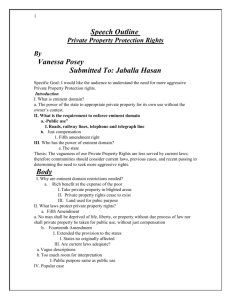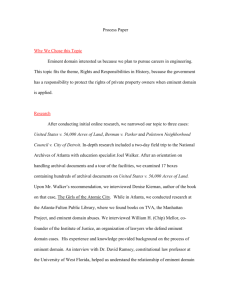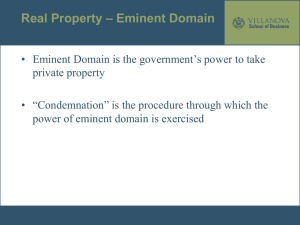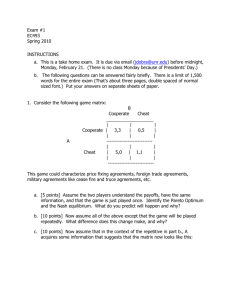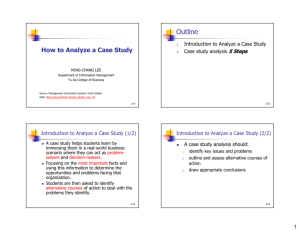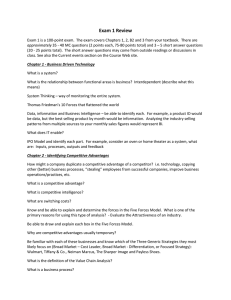sample-posters
advertisement
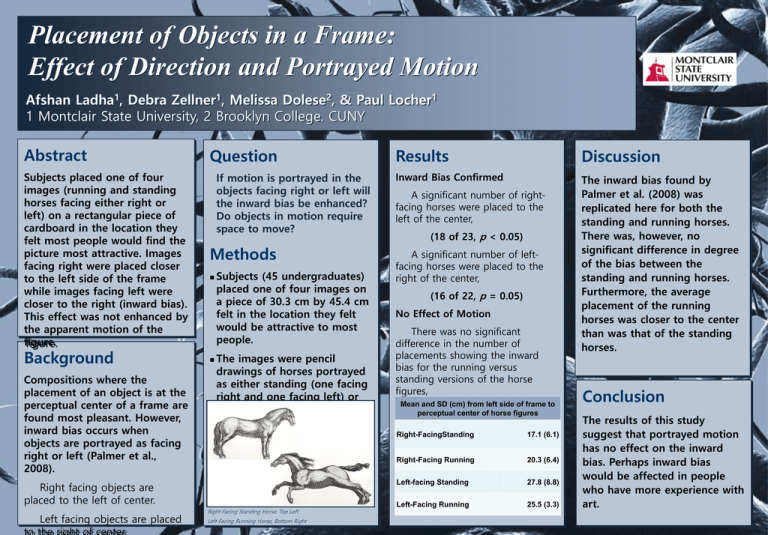
Placement of Objects in a Frame: Effect of Direction and Portrayed Motion 1 Ladha , 1 Zellner , Afshan Debra Melissa & Paul 1 Montclair State University, 2 Brooklyn College. CUNY Abstract Subjects placed one of four images (running and standing horses facing either right or left) on a rectangular piece of cardboard in the location they felt most people would find the picture most attractive. Images facing right were placed closer to the left side of the frame while images facing left were closer to the right (inward bias). This effect was not enhanced by the apparent motion of the figure. Background Compositions where the placement of an object is at the perceptual center of a frame are found most pleasant. However, inward bias occurs when objects are portrayed as facing right or left (Palmer et al., 2008). 2 Dolese , Question If motion is portrayed in the objects facing right or left will the inward bias be enhanced? Do objects in motion require space to move? Methods Subjects (45 undergraduates) placed one of four images on a piece of 30.3 cm by 45.4 cm felt in the location they felt would be attractive to most people. The images were pencil drawings of horses portrayed as either standing (one facing right and one facing left) or running (one facing right and one facing left). Right facing objects are placed to the left of center. Left facing objects are placed Right-Facing Standing Horse, Top Left Left-Facing Running Horse, Bottom Right 1 Locher Results Discussion Inward Bias Confirmed The inward bias found by Palmer et al. (2008) was replicated here for both the standing and running horses. There was, however, no significant difference in degree of the bias between the standing and running horses. Furthermore, the average placement of the running horses was closer to the center than was that of the standing horses. A significant number of rightfacing horses were placed to the left of the center, (18 of 23, p < 0.05) A significant number of leftfacing horses were placed to the right of the center, (16 of 22, p = 0.05) No Effect of Motion There was no significant difference in the number of placements showing the inward bias for the running versus standing versions of the horse figures, Mean and SD (cm) from left side of frame to 2 (χ (1) = 0.91, p > 0.34) perceptual center of horse figures Right-FacingStanding 17.1 (6.1) Right-Facing Running 20.3 (6.4) Left-facing Standing 27.8 (8.8) Left-Facing Running 25.5 (3.3) Conclusion The results of this study suggest that portrayed motion has no effect on the inward bias. Perhaps inward bias would be affected in people who have more experience with art. Chart of the Disciplines Law & Literature in Traditional Legal Education Alex Taub Senior Seminar in Research and Writing in Jurisprudence, Montclair State University, Montclair, NJ Research & Breakdown This research paper addresses the manner in which the discipline of literary analysis has been utilized in combination with more traditional legal studies in order to accommodate the changing needs of legal education. The impact of the legal profession on the United States has continued to expand over the years as has the many aspects of society in which it plays an important role. There has been growing recognition that the skills required for success in a legal career go well beyond the traditional core legal skills and also include such additional skills as effective communication, relationship-building, organization and management, and the recognition and resolution of ethical dilemmas. Greater focus on diversity among both law students and the population at large has resulted in more attention being paid to the societal context of the way in which the law is created and the way it is applied. This has led to a trend towards supplementing the traditional case/socratic methodology, which has been the fundamental approach used in legal education since 1870, with other disciplines among which literary analysis has been particularly popular. Comparative Chart of Disciplines Researched Disciplines/ Perspectives/ Theories Law Literature Legal scholars such as Morawetz and relationship b/w Law Posner believe that while there is a and Literature relationship between the two, it is not what many other legal scholars who support the movement hold it to be. They also question the relevance of that relationship. The relationship between Law and Literature is a relevant one and is acknowledged by many scholars in the discipline. Efforts have been made to integrate the two disciplines to show the similarities in style and methodology of both of their practices. Law contains many different methodologies, but the ones pertaining to legal analysis, critique and legal writing are regarded as comparable to those used in other disciplines. The methodologies in literature and literary analysis are crucial elements in the field. They are similar in nature to those used in the study of law and have been at the core of literature studies since its introduction. Looks at law as structured rigorous and mechanical study of doctrine and policy. As a tool that may or may not assist students of law in helping them to find out more about the nature of law and the skills that can be acquired from the methodologies of literature and literature study. Methodologies Traditional Legal Education Summary & Conclusion This research demonstrates the increasing popularity of Law and Literature programs, as well as their effectiveness in meeting the broader requirements of legal education, while also indicating some issues and questions that remain regarding their most appropriate form and role in the future. SRS, 2009 Transfer of Property Rights: Finding the “Public Good” in Eminent Domain By: Christine Aramini Senior Seminar in Research and Writing in Jurisprudence, Montclair State University, Montclair, NJ Hypothesis It is hypothesized that current law regarding eminent domain transfers property rights to private enterprise without consideration of “the public good.” An interdisciplinary approach is essential to explore this problem because no single disciplinary perspective can adequately address the issue of eminent domain. Discipline of Political Science Discipline of Law The discipline of Political Science sees the issue of eminent domain as essentially being rooted in a “power struggle” over claim to property. Some of the major issues to be examined by a political lens within this issue are: political reactions, divide of various political parties, politics and ideologies of the Supreme Court Justices, as well as grassroots and reform movements. -The Supreme Court Case Kelo v. New London raised the possibility that a city could simply transfer a private home to another private owner, tapping into powerful fears of unchecked government. -- In the past half century, only one other Supreme Court case has sparked a similarly extreme reaction – Roe v. Wade. Touchtone Case: Kelo v. New London: -The Supreme Court found that “public use,” includes private economic development. -Homeowners in New London, CT attempted to stop the city from taking their homes to make way for private development including a hotel complex and condominiums. -The outcome of this case elicited much controversy and outrage over the topic of eminent domain and what exactly is constituted as a “public good.” Disciplines: Political Science and Law Disciplines/Theories and Doctrines Supreme Court Case of Kelo v. New London Issue: what is constituted as “public good” Constitutional Elements Political Science - Reforms of - Legal implications Governors in each - Legal Cases that State result - Policy Options - Legal definition of Political Implications “public good”/ vagueness. - Constitutional Limits - Interpretations of; - Fifth Amendment applications of with - Due Process/Takings regard to eminent Clause domain law. New Jersey State Law - Lobbying for/against (eminent domain) Kelo - Affects on people in state of New Jersey - Legislation is highly political - Cases have political implications Property Law - Legislation made/altered - Cases - Political philosophers - Legal history of such as John Locke eminent domain law - Natural law - Legal meanings philosophers/political - Legal philosophies philosophies of natural law and connections The discipline of Law sees eminent domain as a Constitutional/Legal issue and determines that cases should be decided in accordance to Constitutional Law and the Natural Law that guides it. -The Fifth Amendment to the United States Constitution sets forth that the federal government cannot take private property for public use without just compensation. This “Takings Clause” has been the primary Constitutional limit on eminent domain. -By 1968, with the enactment of the Fourteenth Amendment, “without due process of law” had come to mean “without just compensation. -- The “public use” portion of the “Takings Clause” has raised many questions . --- No general definition of what degree of public good will meet the constitutional requirement for “public use” can be framed and the final determination rests with each individual court as to what constitutes as a “public good.” Conclusions: The power of eminent domain rests mainly within the hands of the appointed and elected officials and those on redevelopment boards and other authorities. These officials must carefully consider their exercise of eminent domain power and the people should organize together in order to help the officials realize the “public good,” that will best serve their needs. SRS, 2009 Uncle Tom’s cabin As A Challenge to Slave Law Andrea Khan Senior Research and Writing Seminar in Jurisprudence, Montclair State University, Montclair, NJ Purpose of Study The purpose of this study is to utilize an interdisciplinary approach to examine the hypothesis that Harriet Beecher Stowe’s novel Uncle Tom’s Cabin influenced change in the law with regard to slavery in pre- to post- Civil War America. Disciplines: Law (Slave Law) and Literature (19th Century American novel) Law Literature Uncle Tom’s cabin American Slave Law Integration Literature Changes Law Civil war Pre-Civil War American law demonstrates tradition of pro-slavery attitude. 1862- American Civil War begins after stagnation in attempts at compromise between North and South over slavery 1862- President Abraham Lincoln meets Harriet Beecher Stowe for first time and playfully states “so this is the little lady who made this big war”- referring to the American Civil War Slavery is an incredibly lucrative institution in the American South as an incomparably cheap source of labor. Novel by Harriet Beecher Stowe is published in 1852. • Uses elements of the popular sentimental novel to influence emotions of readers toward anti-slavery attitude. • Stowe has personal moral objections to slavery , citing her Christian beliefs and the natural rights of all men. Fugitive Slave Law of 1850 Fugitive Slave Law of 1850 passed by Congress forces Northern states to return runaway slaves to alleged owners. Provides no rights for suspected runaways. 1865- Civil War ends along with slavery; 13th Amendment ending slavery is adopted. Dred Scott Decision 1857- US Supreme Court opinion against Missouri slave Dred Scott declares that black persons are not considered citizens under the Constitution. Conclusion Although there were many causes of the Civil War, interdisciplinary research indicates that Harriet Beecher Stowe’s novel Uncle Tom’s Cabin influenced public attitude toward anti-slavery to such an extent as to be a major contributing factor to the eruption of the war, and thus affected change in the slave law. SRS, 2009
